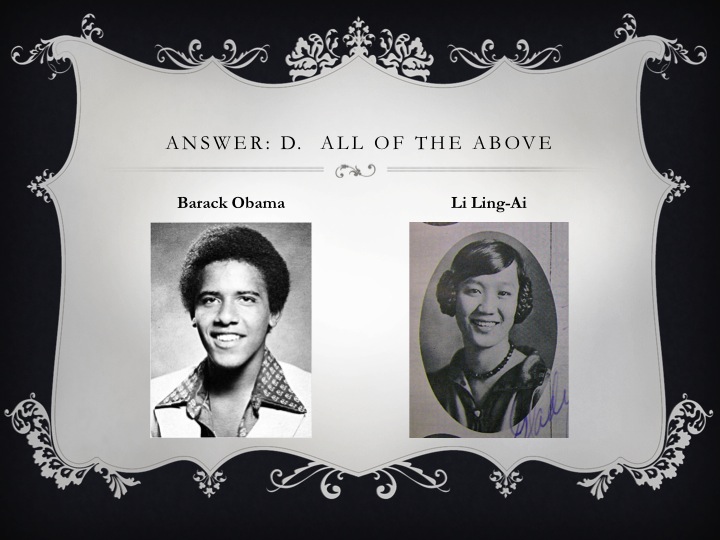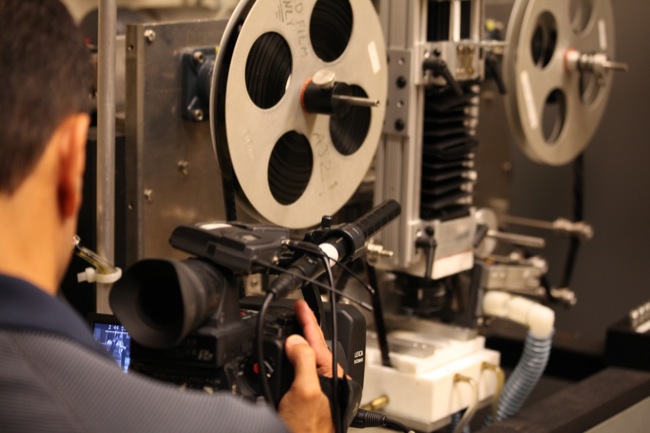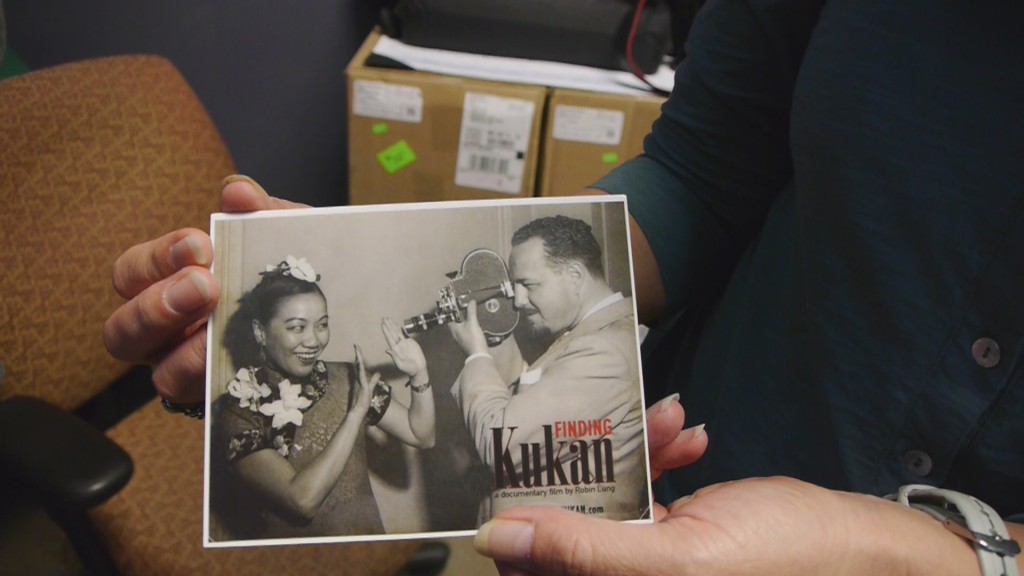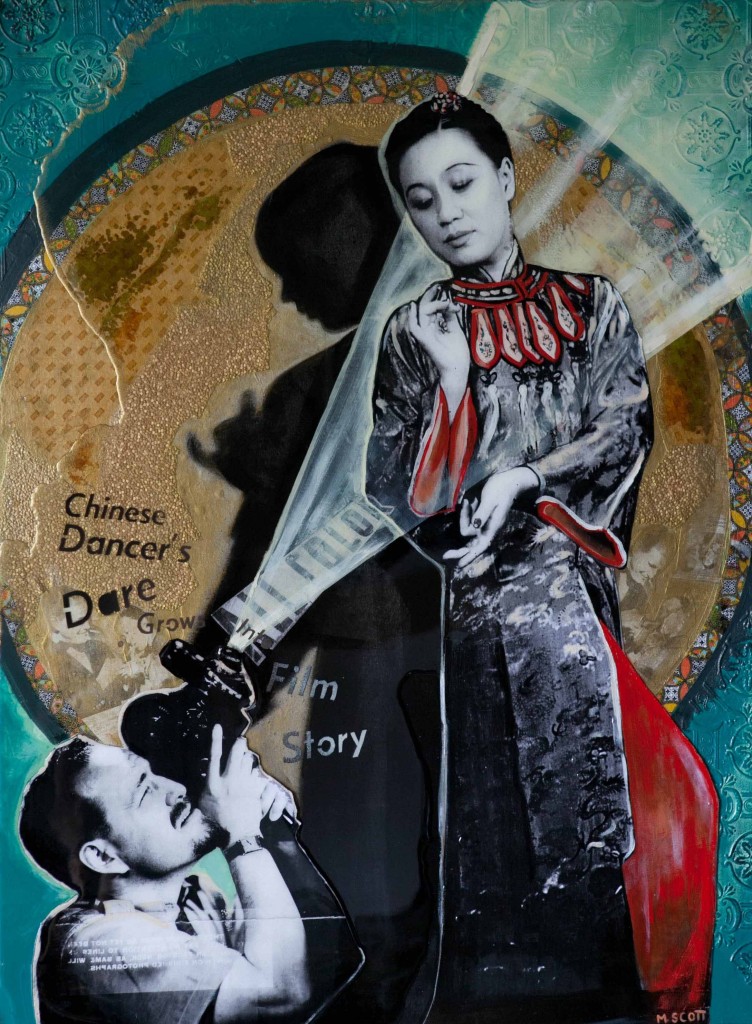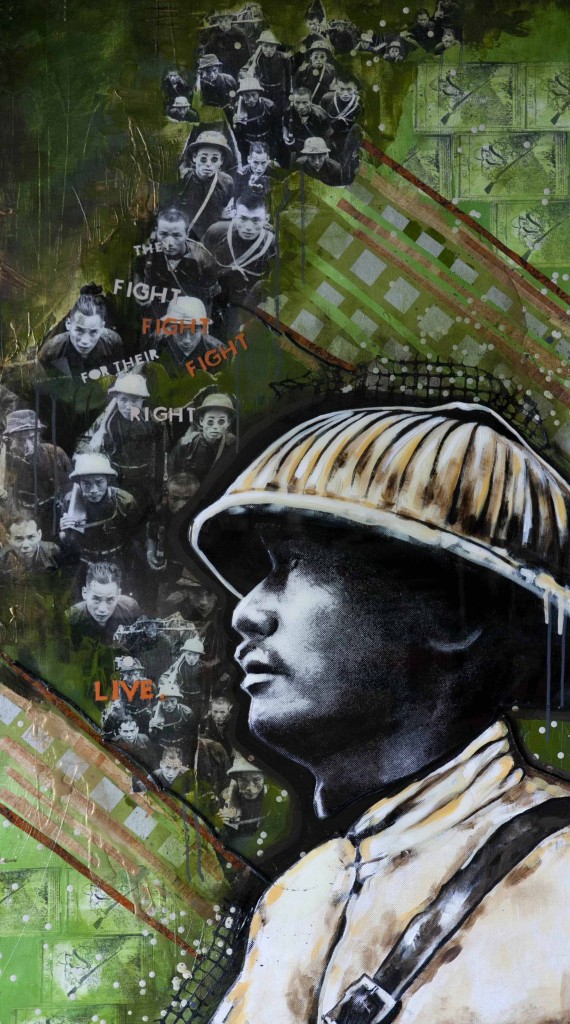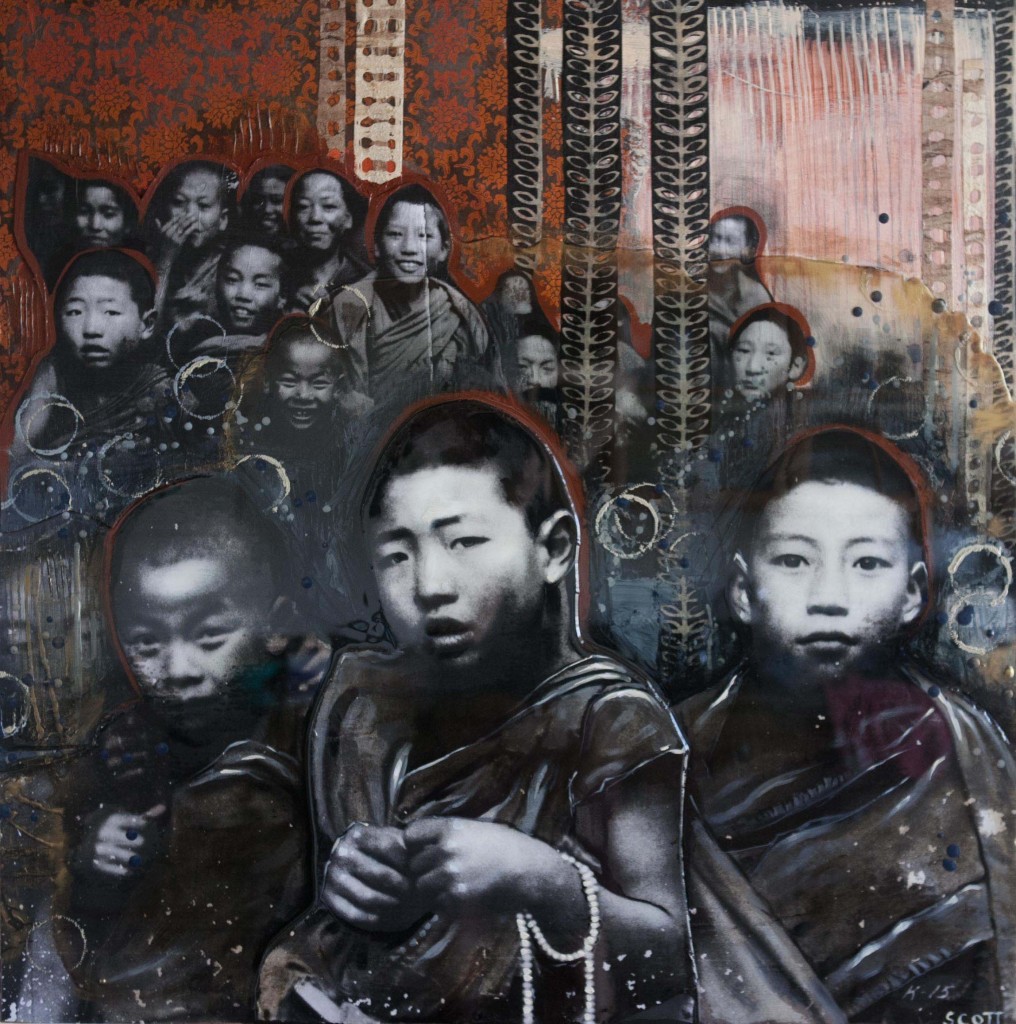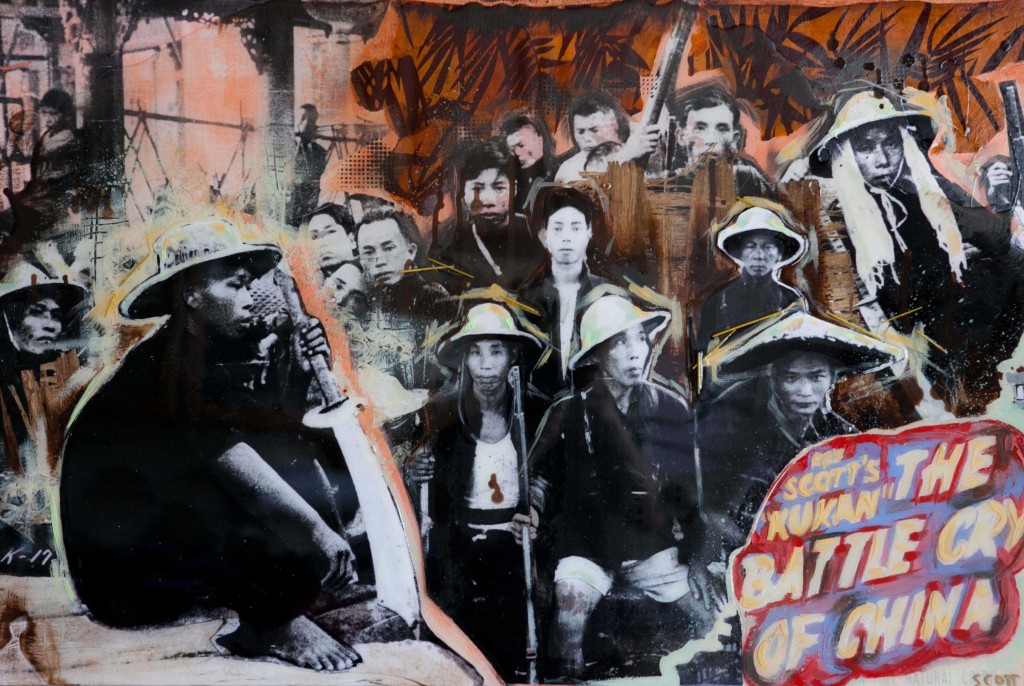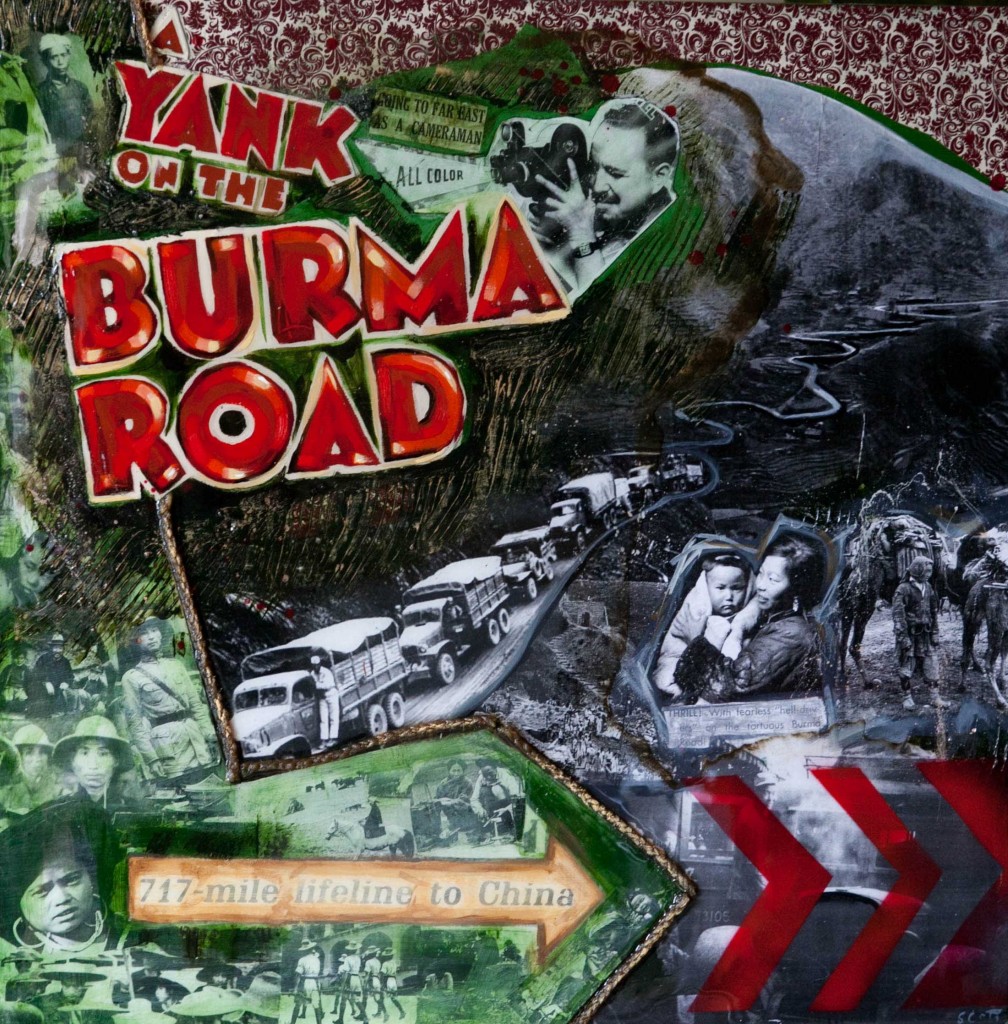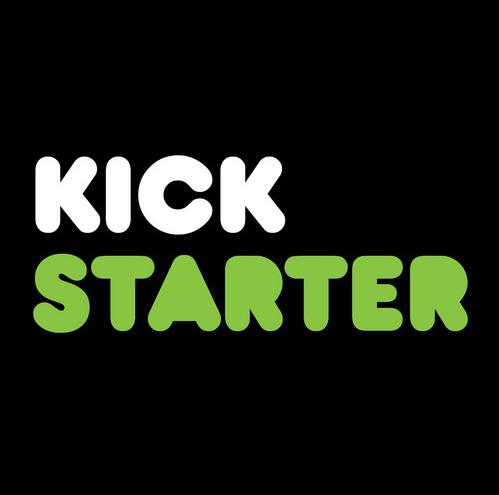Upcoming Screenings:
no event
Follow us on Facebook
HELP BRING FINDING KUKAN TO CLASSROOMS
Sign up for our mailing list.
Tag Archives: Finding KUKAN
The Power of the Press, Part 2 — Roy Cummings
A blog in support of FINDING KUKAN’s 10K in 10weeks “Keep This Film Alive Campaign”.
How was the pioneering female reporter May Day Lo connected to KUKAN’s co-producer Li Ling-Ai? Leads to that question had dried up for me a long time ago. Then last November Honolulu Star-Advertiser reporter Mike Gordon wrote a big feature article about FINDING KUKAN. I received a number of enthusiastic emails about the article and one strange phone call.
“I’m so mad!” Those were the first words Susan Cummings said to me. “I’m sure he knew her. If only he were still here, he could tell you.” She was referring to her husband who was no longer alive. To tell you the truth, I thought Susan might be a raving lunatic. But as we talked longer I realized that Susan’s late husband was Roy Cummings. He’d been a reporter at the Honolulu Advertiser in 1937, the same year KUKAN’s director Rey Scott started working there. Like Rey Scott, he had roots in Missouri. Roy was also notable for trying to unionize the Advertiser at that time. Susan told me he was fired for doing so, was almost run over in a parking lot, and blackballed by the Honolulu Star-Bulletin too. It would take Roy Cummings another 12 years to establish the Hawaii Newspaper Guild in 1949. He seemed just like the kind of guy that Rey Scott would gravitate to.

Roy Cummings founded the Hawaii Newspaper Guild in 1949 (photo courtesy of Honolulu Star-Bulletin)
Coincidentally Roy’s first wife Margaret Kam had been a “person of interest” to me when I was trying to hunt down the real life inspirations for the detective Lily Wu. Because Margaret was a colorful character too – a Chinese actress and reporter in Hawaii who had the gumption to marry a white guy at a time when traditional Chinese families still frowned upon those things.

Margaret Kam (center) mans the all female copy desk at the Honolulu Star-Bulletin during WWII (courtesy Susan Cummings)
Once I made the connection, the conversation with Susan started sparking with names and situations from Roy Cummings’s past. I mentioned that I had been trying to find information on the Star Bulletin reporter May Day Lo, and Susan exclaimed, “May Day Lo was Roy’s first love!” It turns out that Roy and May Day went to journalism school together in Missouri. Roy fell in love with May Day and followed her out to Hawaii.

May Day Lo and Roy Cummings (center) gather with fellow University of Missouri journalism students in downtown Columbia
Now I was the one who was mad that Roy was no longer alive. I felt sure that he’d been acquainted with Li Ling-Ai and Rey Scott in one way or another. He probably could have provided some interesting stories about the two of them and the making of KUKAN. Susan graciously invited me over to her house in Lanikai to look at Roy’s photograph from the time period – the next best thing to meeting the man in person.
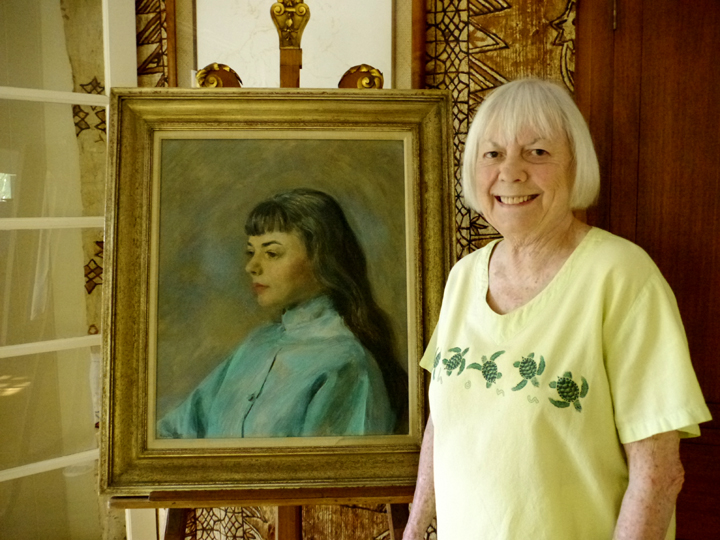
Susan Cummings with Wyeth portrait
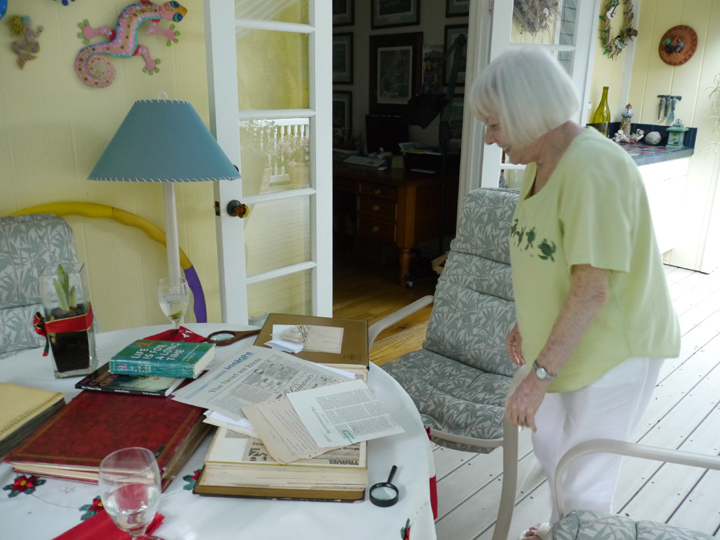
Susan Cummings hunts for clues in her husband’s photo albums
Roy’s photos put more flesh and blood on what had previously been merely names on a page. They also gave me some insight into the lifestyle Rey Scott must have experienced when he first arrived here.

Aloha Tower in the mid 1930s (photo courtesy Susan Cummings)

Like Roy Cummings, Rey Scott holed up in Waikiki when he first got to Hawaii. Could his room have looked like this? (photo courtesy of Susan Cummings)
But the photos didn’t do much to fill in the gaps of the KUKAN story. In fact they brought up more questions than answers. Susan herself was mystified as to what happened between May Day Lo and Roy. Why had he married Margaret Kam instead of May Day? She’d never thought to ask Roy about it when he was alive. I wanted to know if anyone had saved May Day’s papers and if Ling-Ai’s letters or clues to KUKAN were amongst them.
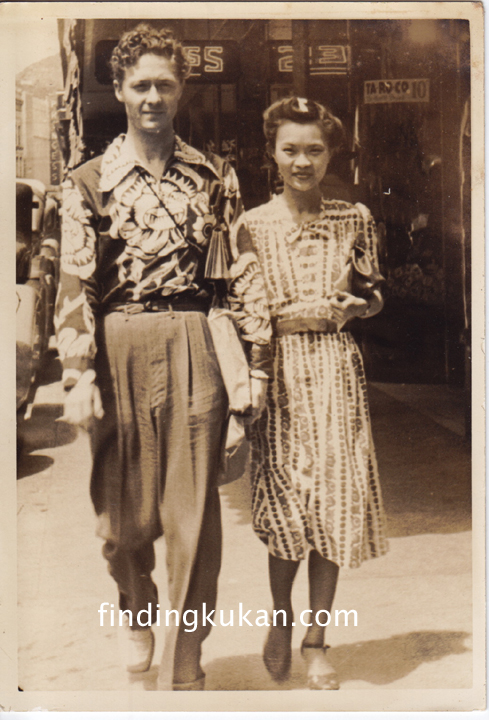
Roy Cummings and May Day Lo in downtown Honolulu (photo courtesy Susan Cummings)
Egged on by mutual curiosity Susan and I exchanged a flurry of emails and research findings in the next few weeks. Susan proved to be a willing and able sleuth, and together we found out some very interesting things which I’ll share in future posts. For now I want to pay tribute to the “father of the Hawaii Newspaper Guild” and thank the ghost of Roy Cummings for putting Susan and I together. Of course the “power of the press” had a lot to do with it too.
Support our 10K in 10 Weeks campaign by clicking the red button. 
(As of 9/24/13 we have raised $7,165 and have $2,835 more to raise by 10/15/13)
May 2, 2013 — Collaborating With Shadow Creatives
I knew when I saw the stunning shadow visuals designer/animator Chris Do did for a GAP campaign that I wanted to use the same technique for FINDING KUKAN. I envisioned Do’s animation being brought to the genius shadow scenes that Larry Reed develops for ShadowLight Productions as the perfect way of carrying the emotion of especially intimate or harrowing scenes in the dramatic narrative of Li Ling-Ai and Rey Scott’s lives.
So it was thrilling to have both Chris Do and Larry Reed in the same room with me today in Santa Monica at Chris Do’s BLIND design studio office space. Larry joined us by SKYPE and conference call from San Francisco (SKYPE can drop out on you when bandwidth is scarce).

Chris Do and Robin Lung SKYPE Larry Reed from the BLIND offices in Santa Monica
After our meeting I realized that I had found two creative geniuses who were also practical producers with years of experience in how to ACTUALIZE a visual idea. The pragmatic, step-by-step path to bringing a new way of visual storytelling to the screen in FINDING KUKAN, just got a whole lot clearer thanks to Larry & Chris.

Chris Do helps Robin Lung lay out a plan of action for creating FINDING KUKAN’s shadow scenes.
I invite you to check out their work HERE and HERE. If you are as wowed by it as I was, please consider contributing to the collaboration process at our Post-Production GIFT REGISTRY. If you have any cool shadow ideas or images you think would work well in the film, please post on our Facebook page at http://www.facebook.com/kukandocumentary and write “Shadow Idea” in the comments section (and don’t forget to LIKE us while you’re at it)!
April 25, 2013 — Major Archival Discovery Starts with a Party
It was my husband Paul who convinced me that I should have a fundraising party. So last October I got many volunteers together to throw one. Terry Lehman Olival helped by sending press releases to the local media and got the attention of Star-Advertiser reporter Mike Gordon.

Mellanie Lee, Debra Zeleznick, Robin Lung and Terry Olival at “A Night in Old Shanghai” fundraiser
“That might be the coolest story I’ve heard in a long time,” Mike said, and promised to write an article on it. The more Mike found out, the more he wanted to know. His article grew and grew. My fundraising party came and went; my Kickstarter campaign came and went.
Finally the opus turned up – a 3‑page spread on the film, complete with color pictures, showed up in the Sunday newspaper and drew response from people as far away as Kentucky!

Mike Gordon’s article “Reel Obsession” appears in the November 18, 2012 Honolulu Star-Advertiser
DeSoto Brown, curator at the Bishop Museum, also read Mike’s article and something clicked. He remembered a donation of lantern slides made to the museum by Betty Li, Li Ling-Ai’s older physician sister, back in the 80’s. In fact the slides were marked as being related to KUKAN! Early in my research I had read that KUKAN’s director Rey Scott lectured with a group of slides, but no one in his family remembered seeing them or hearing anything about them. I had given up on finding them.
So I was on pins and needles last week when I finally connected with DeSoto at the Bishop Museum and had a chance to examine the slides myself. They didn’t disappoint — 97 images of 1937 Nanking, including some with Rey and Betty Li, brought Rey’s first trip to China to life for me in a thrilling way and helped answer some of the mysteries that had been plaguing me for years.
October 8, 2012 — KUKAN Moves from the ER to the Operating Table
Many of you know by now that my documentary FINDING KUKAN revolves around my discovery of the “lost” 1941 Oscar-winning color film of war-torn China called KUKAN. Many of you might also be wondering, where in the H… is KUKAN? If it was found, then why can’t we see it? Well when I tracked down the only full copy of the film it had been sitting in a Fort Lauderdale studio for a few decades and then a Georgia basement for a couple more. Heat and humidity had done its work.
When AMPAS’s Ed Carter and Joe Lindner opened the rusty metal can that contained KUKAN they winced. “Vinegar,” they both said, wrinkling their noses. I learned later that that is a sure sign of deterioration. As Joe examined the 2 reels of film that represented 90-minutes of invaluable color footage of China in 1939 and 1940, he detected both shrinkage and brittleness (more bad signs of deterioration). Joe said he’d seen films worse off…but not many. Things looked pretty grim. If we were in the Emergency Room, this would be time for triage.
Fortunately a deteriorating film takes longer to die than a bleeding human. Two years later, KUKAN has been stabilized but is still in pretty bad shape as you can see by the photos I took of it last week at Colorlab in Maryland where AMPAS sent it to have major restoration work done.
Parts of it are so curled that they will never be able to be re-plasticized (a sort of Botox process for film that hydrates it enough to allow it to lay flat in the scanner without breaking).

The worst part of the 2 KUKAN reels was so curled it looked like the plastic straws you drink out of.
A partial copy of KUKAN that I located in the National Archives (NARA) will be used to fill in those parts that are unsalvageable. The NARA copy was kept in a temperature controlled environment all these years and is in fairly good shape. But even that has to go through a frame by frame scanning process to pull both image and soundtrack from the 16mm strip.
DP Frank Ayala, 2nd Camera Mia Fernandez and I arrived at Colorlab to film the initial frame by frame scanning of the NARA print and learned a lot about the care and effort needed to bring a film back to life.
A.J. Rohner, head “surgeon” on the KUKAN restoration process, assured me that “my patient” could be saved despite its horrific appearance. He gave us a tour of the monster machine that does the scanning – an invention of Colorlab engineer Tommy Aschenbach.

The scanner doing all the work is a fascinating contraption that blinks and whirs and beeps — just like something out of Startrek.
I was entranced by its gorgeous parts, blinking lights and robotic movements — so much more tangibly satisfying to see at work than watching the little gray line creep across your computer screen as your digital footage downloads.
I also learned how the sound from the film will be lifted from the scan, VISUALLY corrected before turning into sound waves and then cleaned and scrubbed to get all the ticks, and hisses out. I was surprised to learn that those little horizontal lines on the edge of the film are what make the sound come alive through the projector – a magical phenomenon when you think about it.

If you look carefully you can see the sound stripes on one edge of the film. The top strip is the badly deteriorated copy of KUKAN I found. Notice the color loss.
From the photo below A.J. identified the camera Rey Scott was using in China as a 16mm Bolex.
Colorlab technician Laura Major just happened to have one in the office that she still shoots with.
Holding that camera in my hands, looking through the tiny viewfinder, and learning that the camera could only shoot 100 ft of film at a time (roughly 2 minutes) gave me a much greater appreciation for Rey Scott’s heroic accomplishment in filming the epic scenes contained in KUKAN, especially the 15-minute sequence at the end of the movie that depicts the massive bombing of Chungking and the fiery destruction of the city.

You can’t believe how tiny everything looks through this viewfinder — no wonder Rey had a hard time focusing in places.
I am more determined than ever to reach our $16,000 Kickstarter goal so that we can keep following the magical resuscitation of KUKAN and track the amazing story behind its creation. Please join me on this journey, it’s going to be an incredible ride!
October 3, 2012 — Michelle Scott Delivers a Knock Out with her KUKAN SERIES
When I first made contact with Rey Scott’s granddaughter Michelle Scott and filled her in a little about the story behind KUKAN, she felt a need to transfer that story into paint and shared with me a vision she had for creating a whole room of paintings dedicated to her grandfather and KUKAN. It seemed like a far-fetched dream back then. So I was more than a little excited to go to Atlanta to witness the opening of Michelle’s solo show — THE KUKAN SERIES. Michelle hadn’t shared any images of the new work with me, so I wasn’t prepared for the visual sweep and emotional power of the work. It literally brought me to tears. Here are a few choice pieces from the show. WARNING — these photos do not do the pieces justice. The real pieces have an almost three-dimensional quality that allows the viewer to enter into the scene and experience a little of Rey Scott and Li Ling-Ai’s world back in the late 30’s.

Artist Michelle Scott with “Start of a Journey” the exclusive premium available for a $5,000 Kickstarter pledge (partially tax deductible).
The 36“X36” piece that Michelle created exclusively for our Kickstarter fundraising drive is displayed right in the front window of 2Rules Fine Art in Marietta. Casual strollers walking down the sidewalk can’t help but be pulled in to find out with the imagery is all about. For close up details of this painting go to our Kickstarter home page.
The KUKAN Series contains a few gorgeous tributes to Li Ling-Ai the Chinese American author who was the uncredited co-producer of KUKAN with Rey Scott.
The work below contains images of Li Ling-Ai from three different decades and three different locations (the old Honolulu Academy of Art, Beijing China, and New York City)
There are also fabulous pieces that provide a visual montage of the China witnessed through Rey Scott’s camera. He took both stills and 16mm color movies. Some of his old cameras are on display too with the original stills.
Rey Scott traveled all the way to Tibet and filmed some of the first color footage of prayer rituals there.
Michelle’s take on the original KUKAN lobby cards for the United Artists version of the film.
Rey Scott also filmed the famous Burma Road as it was being built.
A reminder of the British influence in Hong Kong which fell to the Japanese in 1941.
A whole movie could be made just about the baby giant panda bear that Rey Scott brought from Chengtu to the Chicago Zoo. Originally christened “Li Ling-Ai” by the foreing journalists in Chungking, it was later named Mei Lan when it was identified as a boy panda bear.

“Portrait of a Lady” and “For Him” are the first two pieces that Michelle Scott made in the KUKAN Series
There are many more gems in this show. But the emotional highlight for me was being able to see the first two portraits of Rey Scott and Li Ling-Ai that Michelle did. I first saw them on her website before we even knew each other and before she even knew who Ling-Ai was. This was the first time I was able to see them both in person. Since the pieces had been sold to different collectors several years ago, this was also the first time they were reunited in the same room for quite some time — a symbol of hope for me as I continue to seek funding to finish FINDING KUKAN.
If you are in the Atlanta area make an effort to see this historic show — up only until October 26, 2012
September 15, 2012 — A Fresh Take on Fundraising
Writing grant applications is a lonely business, and receiving rejection letters from granting foundations is depressing to say the least. Don’t mistake me. Grant monies have been very helpful to this project. And since we need more grants to get this film finished, we will continue to apply for them and be overjoyed if/when we get them. However, sitting back and wiating to hear if some unknown panel of judges will deem your project worthy of X,Y,Z’s support, can leave a filmmaker feeling powerless and dejected. What to do?
Several months ago I decided to take a part of fundraising into my own hands with the help of KICKSTARTER — an online crowdsourcing platform that creative types from first-time inventors to veteran filmmakers like Charlie Kaufman have been using to raise funds for their projects. The idea is that even with small donations, you can raise a decent chunk of money if enough people get behind you. As someone who was raised to be independent and stand on my own, it feels uncomfortable to ask for help, especially monetary help. But as soon as I started telling people about my plans, Voila! a major shift occured in the energy around my film. I soon had offers of help from friends, colleagues and complete strangers who got excited about getting involved in a creative project and helping it come to fruition. Here are some of the amazing volunteers who’ve joined TEAM KUKAN recently.

Anna Guerin, Debbie Buccigrossi, Robin Lung, Pam tong, Maggie Barrett, and Terry Olival at a fundraising summit for FINDING KUKAN
There are many more people not pictured who have offered goods, services and morale support. Suddenly fundraising doesn’t feel like a lonely, depressing business anymore. It’s still not easy. It’s been challenging, time-consuming, and stressful at times. It’s also a little scary. The way Kickstarter works is that if you don’t raise ALL of your goal you get NOTHING. So I expect the Kickstarter campaign (scheduled to run from Sept 29-Nov 17) will run me more than a little ragged before it’s all through. I also expect it will be an exhilirating ride that many new friends will join me on. I hope you’ll be one of them.
Here is a sneak peek at a couple of premiums we are offering to our Kickstarter pledgers.

Collectible Full-color Posters for FINDING KUKAN are just a couple of our amazing Kickstarter premiums.
(Images courtesy of Hollwood Chinese Collection & Michelle Scott Art)
Want to join the effort? Kickstarter is administered through Amazon. If you shop on Amazon, donating is easy. If you’ve never shopped on Amazon, consider setting up an account to make the Kickstarter donation process go smoothly. Hate the idea of doing anything financial on the internet? Don’t worry, we are giving people the old-fashioned option of putting a check in snail mail too!
So what am I learning on my latest fundraising venture? To FACE MY FEAR, EMBRACE NEW FRIENDS, and HAVE FAITH that things will work out. Have experience fundraising on Kickstarter? Please share by commenting.
September 8, 2012 — Fashion Photos Discovered
Late tonight I am putting off writing a presentation for upcoming October events and browsing the wonderful photos of Li Ling-Ai that Softfilm blogger Durian Dave discovered in the LIFE photo archives. These are all of a United China Relief Fashion show in May 1941 and taken by Alfred Eisenstadt (note KUKAN would premiere the following month in NYC — it must have been a heady time for Li Ling-Ai).

Li LIng-Ai models traditional Chinese robe at May 1941 fashion show for United China Relief.
I love seeing this crowd shot of all the NYC socialites wearing their hats. While viewing these photos, a bell rang in my head and I remembered some of my research at the Columbia Rare Book and Manuscript Library. A fashion show had been held at the Hotel Pierre. Sure enough, I compared a current photo of the penthouse ballroom and the archways are the same. I got chills remembering that I had been to a wedding at that same spot back in the 90’s.
I had no idea that Li Ling-Ai participated in the fashion show when I took those notes at Columbia a couple of years ago.

Li Ling-Ai, with actress K.T. Stevens, James Blaine, Lee Ya Ching, and unidentified Chinese woman
Li LIng-Ai is seen here posing with James Blaine, national chairman of United China Relief and the president of Marine Midland Trust. He was just one of the NYC CEOs that Henry Luce recruited to lead the huge fundraising effort to aid China prior to WWII.
These photos bring this 1941 event to life for me in a whole new way. However, LIFE photographs are notoriously expensive to license. So if I’m going to use them in the documentary, I’m going to have to have a fundraiser myself. Speaking of which… Be on the lookout for our Kickstarter launch in October, and if you’re in Honolulu on October 28, come to our “Night in Old Shanghai” cocktail party benefit where we will pay homage to the efforts of these 1941 fashionista fundraisers.
July 24, 2012 — An Earfull At the Ear Inn
As the weeks wear on and I get closer to the deadline for submitting a grant application to the NEA, I have periods of doubt and wonder if it’s even worth it to try for such a prestigious thing. And if I don’t get awarded a grant what will it mean – that the project is unworthy, and I should give up?
Glancing through pictures I took in May I’m reminded that getting grants and making Art are two different things. These black and white snaps were taken on a hot summer night when I joined my husband Paul and our friend Peer at one of NY’s oldest bars – The Ear Inn on Spring Street.
As I ate muscles at the bar and listened to old-time jazz, a woman named Katerina introduced herself. She had an intriguing accent and was very charming.
Several minutes later her friend Roland joined her – an artist, he showed her photos of his latest work on his Iphone.The striking shadows in his imagery prompted me to talk about the ideas for shadow play I had in mind for FINDING KUKAN.
For some great use of shadows, you should see THE THIRD MAN, said Roland. He sounded like he knew what he was talking about. When I got home I looked up Roland’s website – photos of his performance pieces made me think of all the possibilities before me. The doors to creation opened up a crack.
As I watched THE THIRD MAN for the first time the doors were thrown wide open. Every shot was a compositional gem and fired up ideas in my head for ways to visualize my own search.
I’m hanging on to the DVD so I can watch it for the third time – a reward I’m going to give myself after getting that grant app finished. You DO need a lot of money to make movies, but you DON’T need a lot to enjoy the heck out of them.
Thanks to Roland Gebhardt and the Ear Inn for reminding me of why I’m writing grants applications in the first place.
Whether it’s the bar, the gym, or the beach, we all need to leave the desk once in awhile to get a fresh perspective. Where do you go when you need a creative breath of fresh air?
July 8, 2012 — Kickstarter Plans Get Under Way
Well to offset my terrible experience of having my cameras and jewelry ripped off, let’s talk about one of the lucky things that have happened lately. The new FINDING KUKAN teaser has inspired several amazing women to volunteer their talents to help develop the film! All amazing creative professionals in their own right, Pamela Tong, Magnolia Barrett, and Debra Zeleznik recently gathered at my house to talk about how to get the film to the next step. We were guided by the great research volunteer Notre Dame student Camille Muth did for us.

Robin Lung, Pamela Tong, Magnolia Barrett and Debra Zeleznik hold brainstorming session for FINDING KUKAN.
Right now our most immediate need is to raise funding to complete the film. So we are planning a KICKSTARTER CAMPAIGN to begin in OCTOBER. Why Kickstarter you might ask?
#1. IT WORKS. Crowdfunding– it’s what PBS and NPR have been doing for years — the phone in fund drive format where you get a nice little gift and mention on the show for making your donation at a particular time. Kickstarter (administered by Amazon) is just an online way of doing it and is structured so that independent creative types can have a ready made platform to launch their own crowdfunding campaigns. Check out a couple of amazing documentary campaigns here and here.
#2. GRANTS ARE GONE. Well not totally. I’ve been lucky enough to get a couple of small grants in the past and will continue to write onerous grant applications to try to capture what little funding is still available to documentaries — my Executive Producer Kimberlee Bassford pointed out that it’s easier to get into Yale University than it is to get most major film grants. Even directors with several major PBS documentary series under their belts are finding it hard to make films with the traditional funding available in this tight economy.
#3. IT’S FUN. To learn more about Kickstarter I’ve donated to a couple of projects myself. Donating makes you part of a team and gets you emotionally invested in someone else’s creative project. It’s energizing and inspiring to be part of a group effort to create something of lasting value. Plus there are some fun premiums you can get for donating.

Debra suggests a custom-made bracelet made of mah jong tiles as a possible premium — I LOVE IT!
Do you have any experience with Kickstarter or other fundraising efforts? Can you give us some pointers on how to run a successful fundraising campaign? Do you have an idea for a great premium to give to future donors? Don’t be shy! We need all the help we can get. Please let us hear from you!







